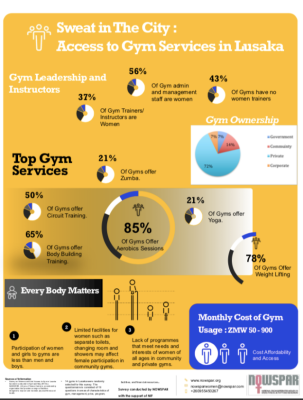She Leads Survey
“We must cultivate a generation of women who have vision and integrity, women who are sensitive to gender issues, who will have a purpose to achieve when they take up leadership positions- advocating for equal opportunities, empowerment of women and girls in sport” Matilda Mwaba NOWSPAR Executive Director.
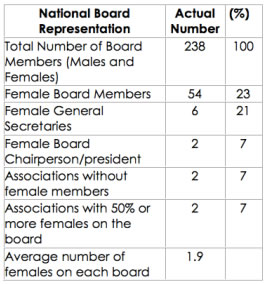 The latest Women in Sport Leadership Survey was conducted by NOWSPAR in March, 2015. NOWSPAR conducts this survey to establish the extent to which women are being represented on the boards of National Sports Federations.
The latest Women in Sport Leadership Survey was conducted by NOWSPAR in March, 2015. NOWSPAR conducts this survey to establish the extent to which women are being represented on the boards of National Sports Federations.
Over the years, the trend has been that leadership among women in Sports federations has been generally low.
This year’s survey was comprised of 29 sports federations.
The percentage of Female Board Member is 23% as compared to men 77%.
21% of associations have have female General Secretaries.
7% of associations have female Chairperson/President
7% of associations have female Board Member at least 50%.
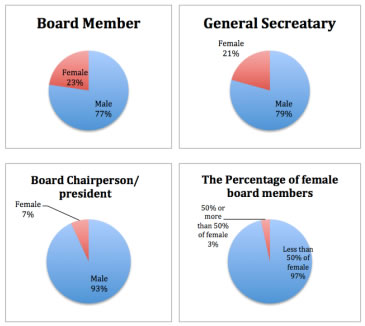
Since the survey is conducted regularly, the table below summarises the findings over the years for the surveys conducted.
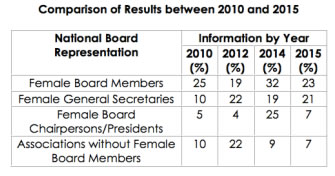
Unfortunately, the percentage of female Board Member has declined 9% since 2014. The result shows that there is a big gap between men and women in decision making positions in sports. Even some of the organisations have put a effort to promote women at leadership position, the progression has not been appeared in the result in sports environment.
It is important that more associations and organisations take serious attention to this gender gap and work together to close down this gap.
The survey was conducted by Ms. Aya Noguchi, Ms. Natasha Lemba, Ms. Chikondi Mvula and Ms. Maketo N’gombe. This work is generously funded by the Norwegian Olympic and Paralympic Committees and Confederation of Sport (NIF), as part of our Every Body Matters II Programme.
2012 Leadership Survey: The survey was undertaken as a contribution to a global survey for the Sydney Score Board on the participation of women in sport leadership of national sports associations in Zambia. It has also helped inform NOWSPAR’s advocacy and awareness work.
About the Sydney Score Board: The Sydney Score Board is a legacy project of the 5th World Conference on Women and sport held in Sydney May, 2010. The project monitors the representation of women in sport leadership in countries and acts as a source of data online: www.sydneyscoreboard.com
Survey Process:The survey presented four questions to each association including, number of Executive Committee Members, number of those who were female, gender of Chairperson and gender of Chief Executive Officer or General Secretary. Associations participated voluntarily, 23 of the documented 43 National Associations in Zambia participated. A mix of large, small, popular and elite sports were included. Information was gathered through interviews with board presidents.
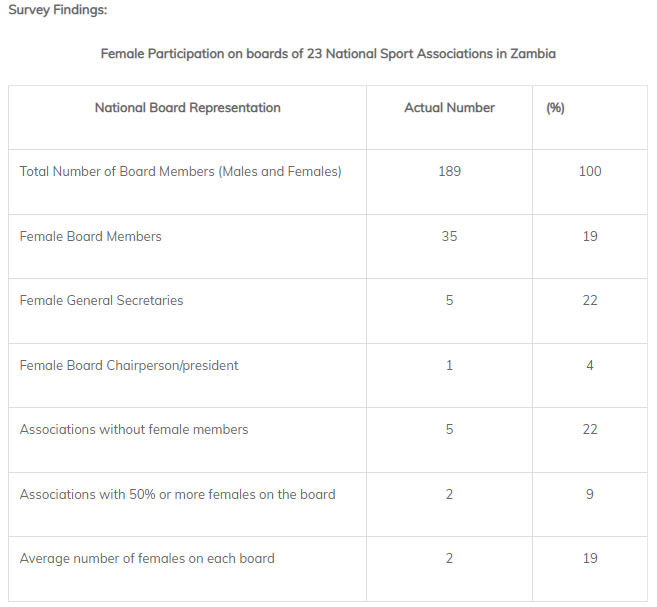
Brief Analysis
Trend: The survey found that the percentage of female board members has slightly decreased since 2010. There has been a decrease in the number of associations represented by 50% or more women and an increase of 12% of the associations without any female members.
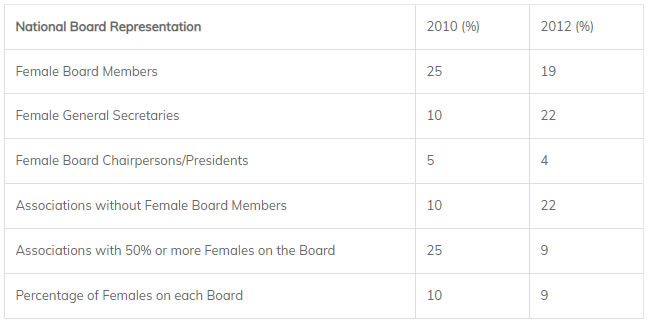
Overall participation of women: It was found that women accounted for a total of 35 (19%) members out of the 189 board members across 23 organizations. There was one female board president who was found in the Netball Association of Zambia. This is due to netball developing over many years as a sport for women. 5 of the women in leadership were general secretaries. This is an improvement from 2010 when there was only 2 general secretaries. This suggests that women are moving up into positions of greater responsibility and authority.
Decision making process
Promote revision of institutional constitutions and guidelines to ensure compliance to national gender sensitivity principles and goals Capacity development of associations in gender mainstreaming Encourage the government to allocate resources and the budget to organizations working towards reaching the 50% target of participation according to SADC and MDG targets We would like to thank the Associations in charge of the following sports codes that participated in this survey:
Basketball, Baseball and Softball, Chess, Deaf, Martial Arts, Amateur Swimming, Table Tennis, Cycling, Rugby, Netball, Judo, Rowing and Canoeing, Squash, Body Building and Fitness, Cricket, Pool, Taekwondo, Tug of War, Volleyball, Football and Weightlifting.
NOWSPAR thanks the National Sports Council of Zambia for their co-operation in this survey and our Interns Ms. Natasha Lemba of University of Zambia and Ms. Jess Howard of University of East Anglia.
The survey was generously funded by the Norwegian Olympic and Paralympic Committees and Confederation of Sport (NIF), as part of our Every Body Matters Programme.



